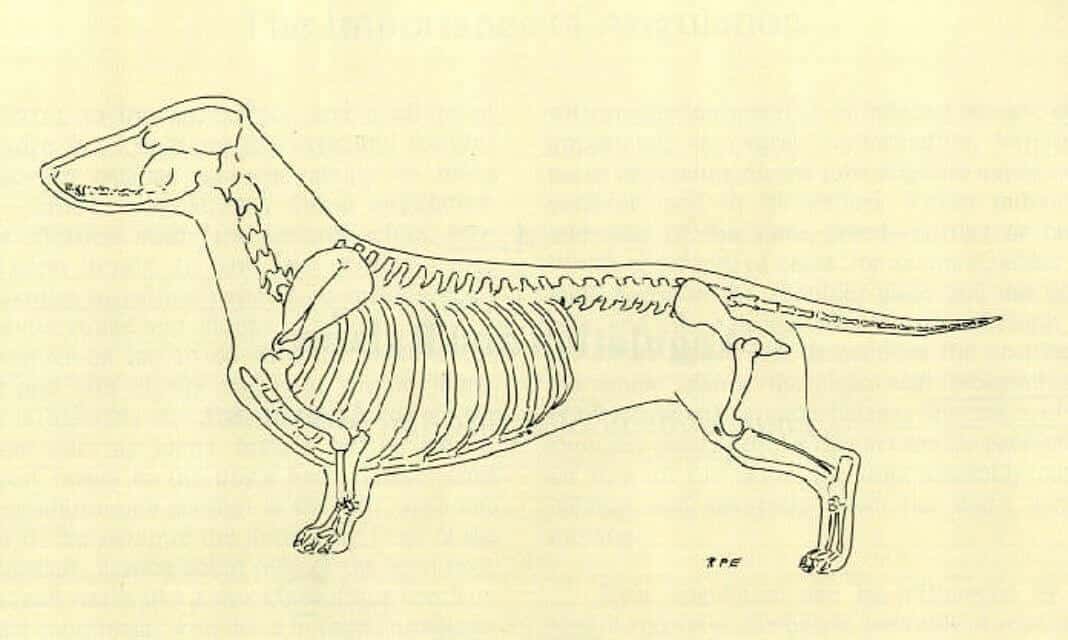
Home » Judging the Dachshund

(This article has been revised by the author to reflect the current AKC Breed Standard approved by the Dachshund Club of America in 2017.
Many judges find the Dachshund difficult to judge. After all, it is a dwarf breed. It comes in two sizes, Standard and Miniature, which are judged together in all but the Open Miniature Class, and there are three distinct coat types. This article is intended to help elucidate how to approach judging this breed. Dachshunds are not to be rewarded because they are “cute” or “funny.” Dachshunds were bred to be hunters that flush and track game. This is an extremely versatile breed, in fact, the only breed that excels in the field, going to ground, retrieving, and tracking. Though many breeds excel in one or two of these activities, the Dachshund is the only breed that excels in all four. Although an achondroplastic (dwarf) breed, there should be nothing awkward or unbalanced about them. They are a Dachshund with great movement, reach and drive, as the Breed Standard reminds us, “clever, lively and courageous to the point of rashness, persevering in above- and below-ground work, with all the senses well developed.” This article is based on the American Kennel Club Standard. While there are slight differences in international Standards, the approach to evaluating the breed should not be different.
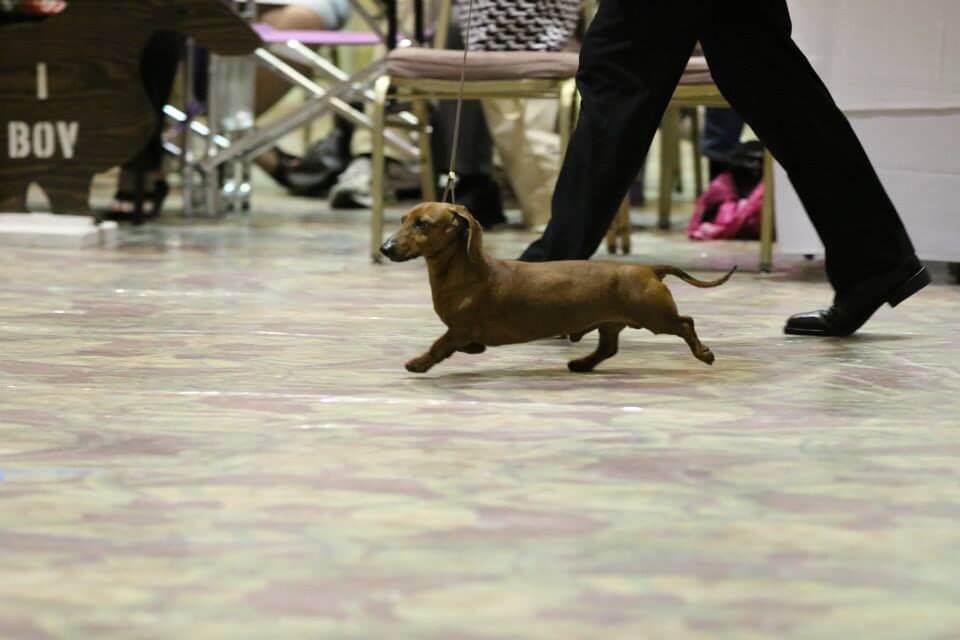
So, how does one begin the evaluation of the Dachshund? First, by remembering the three L’s: Long, Low to the ground, and Level topline. The Dachshund’s conformation allows it to hunt badger below ground without getting stuck or running out of air. When I bring a class into the ring, unless it is an exceedingly large class, or Winners or Best of Variety, I do not want the handlers to stack their dogs but to first take them around the ring. This gives a first impression of the quality of each dog in the class, as structure can best be seen through movement. It also gives the exhibits, and the handlers, for that matter, the opportunity to calm down. Even with singleton classes, I will not have the dog put directly on the table without first gaiting around the ring. The judge can see balance and how well each exhibit propels itself around the ring. In this first go-around, the judge should be able to identify which exhibits are of better quality.
When a dog is on the table, I first view it in profile and look for balance. While the Standard does not specifically mention it, in a balanced dog, the length from tip of nose to occiput should be the same as the length of the neck and the depth of body. The distance from the point of shoulder to the hock should equal about three head-lengths. We want to see a level topline, a prominent forechest, and a neck that is long, slightly arched at the nape, and flows gracefully into the shoulders. There should be no suggestion of a right angle at the insert of the neck into the shoulder. We also look for good shoulder lay-back and a return of upper arm that places the back of the front paw directly under a vertical line dropped from the withers. The rear angulation should mirror the front angles, with hocks well-let-down and perpendicular. A pencil placed across the hocks should not roll off. The tail should be set-on as an extension of the topline.
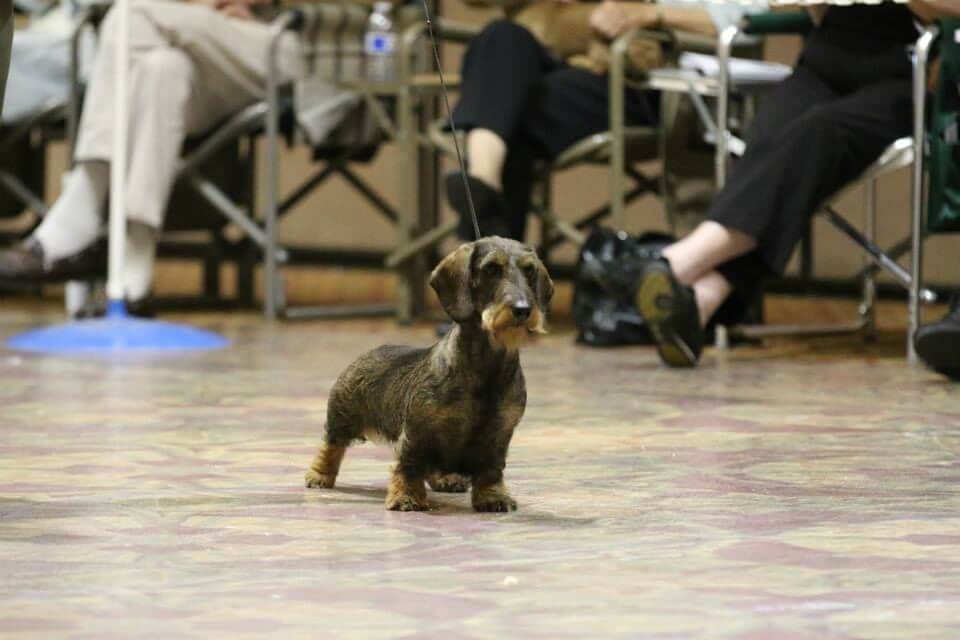
Next, approach the exhibit from the front and check the head, which should taper uniformly from the backskull to the nose, with ears near the top of the head (not at eye level), essentially framing the head, which affects the expression and type. Eyes should be almond-shaped, dark-rimmed, and dark. Round eyes are a fault. Dapple dogs may have wall (blue) eyes, which are otherwise a serious fault and a disqualification in piebald patterned dogs. The bite should be scissors and the underjaw hinged well back of the eyes, with strongly developed bones and teeth. Weak underjaws and snipey muzzles should be faulted, as a hunter has to have a punishing bite.
Evaluation of the front is critical, as it is a distinguishing feature of the breed and the Standard spends more time describing it than any other part of the dog. The prosternum should be so prominent that dimples are visible on both sides of the chest, which should appear oval and extend downward to the midpoint of the forelegs. The shoulders should have good angulation, be well inclined, and have proper lay-back or placement. This front is more angled than with most hounds, requiring right angles between the shoulder blade and the upper arm and between the upper arm and the foreleg. The front “wraps around” that chest, forming parentheses, if you will, with the shoulders being wider than the wrists. The feet may be inclined slightly outwards and should be tight and compact. As with any hound, splayed feet are very undesirable.
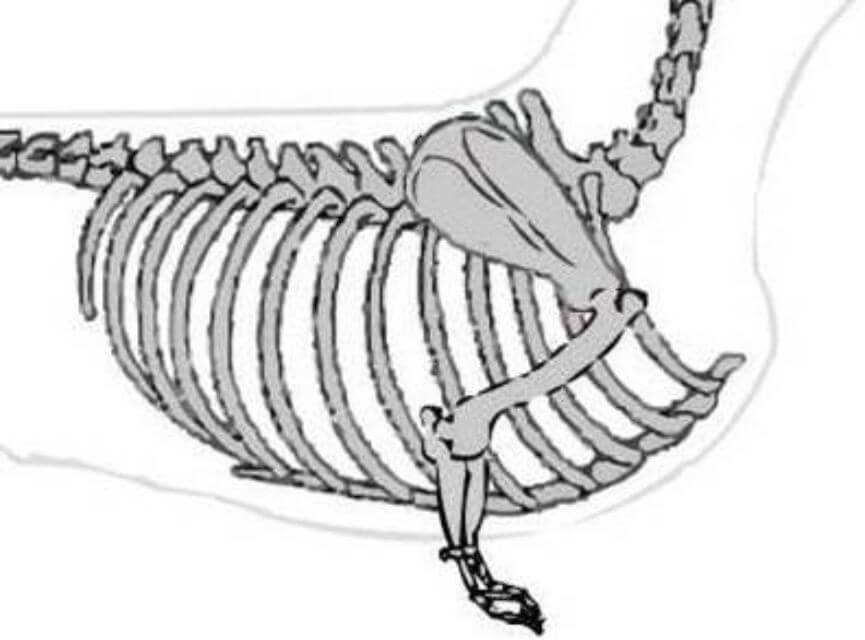
Moving to the side, I place my right hand on the withers and check shoulder placement and run my left hand down the front of the neck and feel the forechest. I then place my left thumb on the highest point of the withers, my second finger on the point of shoulder, and then swing my thumb to the elbow. This allows me to evaluate the front angles and whether there is equal length of shoulder and upper arm. The shoulders should be well laid-back and form a right angle with the return of the upper arm. The shoulders and upper arm should be of equal length so that the elbow falls directly below a vertical line dropped from the withers. We find that, as with many breeds, Dachshunds often have problems with their fronts, due either to straighter shoulder angle or to short upper arm, which restrict the reach needed for proper movement. While holding my right hand on the withers, I run my left hand from in front of the forelegs to the end of the keel, which should extend well beyond the front legs and blend into the underline. Lack of adequate keel is a serious structural fault. I then put my hands on either side of the ribs to feel how capacious they are, and move them back to the last rib. The ribbing should extend well back, about two-thirds the length of the dog, in order to provide support for the long back. If you are not checking forechest, front angulation, length of keel, and ribbing, you are not doing a breed-specific examination! There should be a waist at the strong loin. My left hand moves to the base of the tail and my right runs the length of the tail, checking for placement and kinks or abnormalities.
The rear should be strong, with angles of the hip, thigh, and second thigh corresponding to the front angles, and again, bones of equal length. The hocks should be well let-down and perpendicular. I also like to feel the rear muscles, as the Dachshund is a hunting dog and should have good muscle tone.
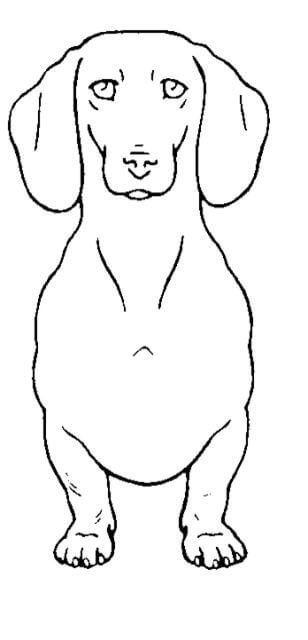
We have examined on the table; now we need to judge the dog on the ground as it moves. On the down and back, you want to see the whole rear pad facing you; this connotes proper rear drive. The legs should move parallel. Bouncing, eggbeater movement or sidewinding indicate that the front is under-angulated in relation to the rear. As the dog returns to you, you want to see the wrap-around front with the forelegs curved and narrower than the shoulders, with no appearance of daylight between the elbows and the chest. Lack of wrap-around leads to a wide, rather stilted and nearly rolling motion. On the go-around, the gait should be effortless, smooth without rolling or bouncing. You want to see good reach in front without any extraneous lift. The extension of the rear legs must equal their forward reach, forming a virtual equilateral triangle.
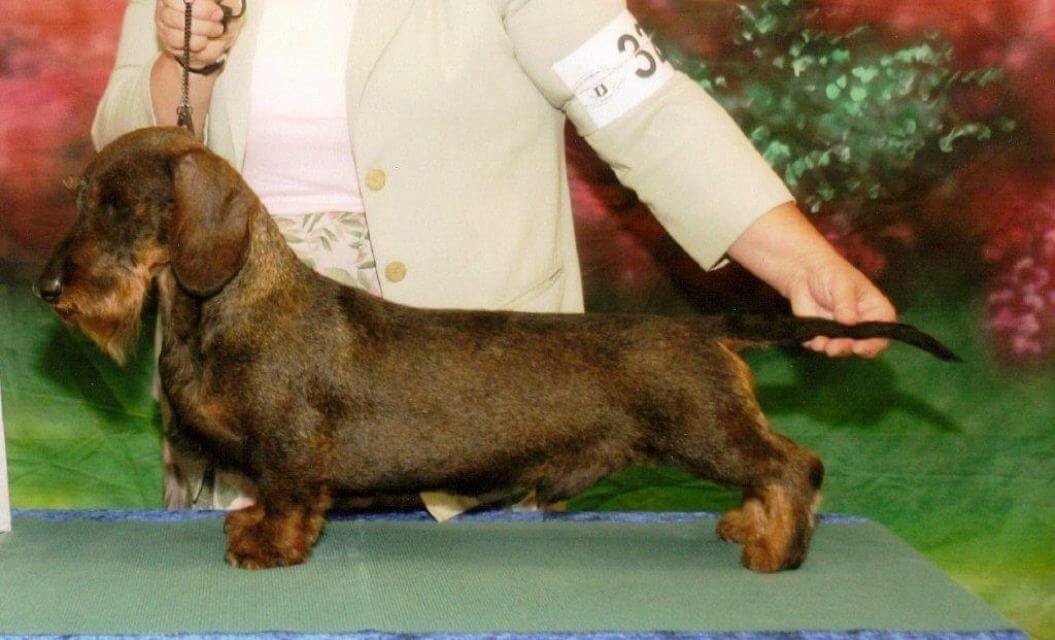
There are three varieties of coat: Smooth, Long, and Wire. The Smooth coat is short, smooth, and shining. The tail should not have a brush nor be partially or wholly hairless. The Long coat is long, sleek, and glistening, often wavy, with hair that is longer on the chest, the underside of the body, the ears, and behind the legs. On the tail, the hair reaches its greatest length and forms a flag. Too profuse a coat that masks type is undesirable. There are recessive Longhairs shown. If there is longer hair on the ears, behind the legs, and on the tail, it is acceptable. The Wire coat should be a harsh outer coat with a softer undercoat. With the exception of a beard and eyebrows, the body should be covered with a uniform, tight, short, rough, hard outer coat with a softer undercoat. The absence of an undercoat is a fault, as are a soft outer coat, or curly or wavy hair on the body. From a distance, the Wire should resemble a Smooth. While correct structure is of prime importance, coats distinguish the varieties and are important indicators of type.
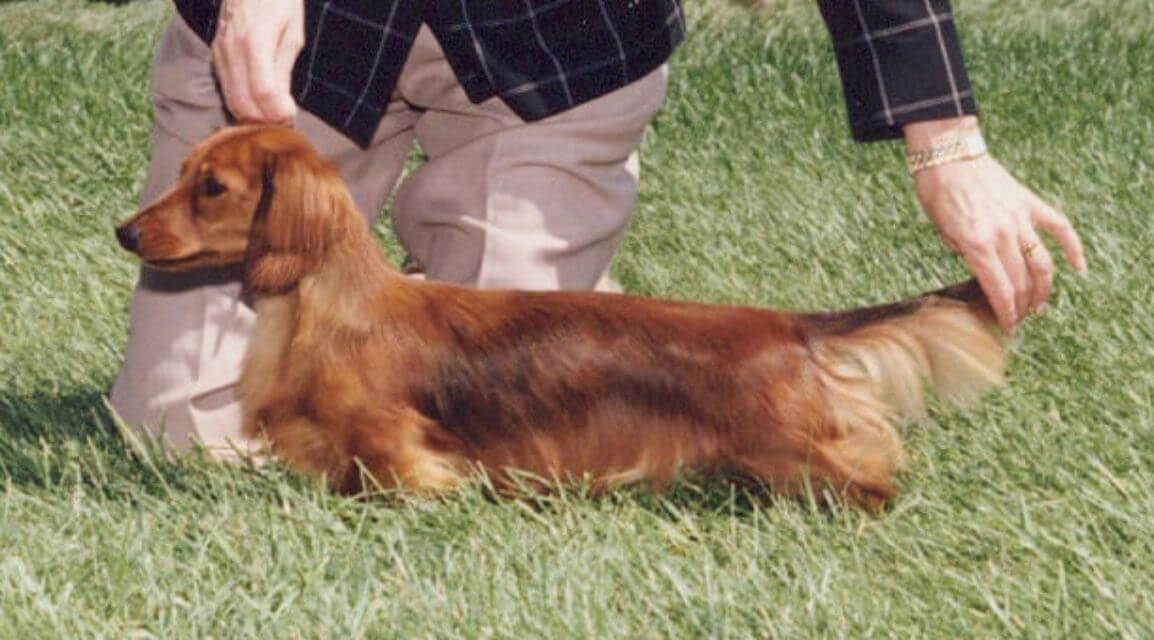
Acceptable colors and patterns are described in the Breed Standard. In 2006, the membership of the Dachshund Club of America (“DCA”) voted to remove the double-dapple (double-merle) pattern from the Standard, and in 2017 added piebald as an acceptable pattern. The Standard mentions three times that a small amount of white on the chest, while not desirable, is acceptable. Dapple Dachshunds may have a larger amount of white on the chest. The piebald pattern is described as clearly defined areas or patches of white on any acceptable one-colored or two-colored dog. While ticking is allowable, there is no dappling or lighter areas within the colored areas. Eyes are never partially or wholly blue, which is a disqualification. The head must not be more than 50% white, and a color other than white must cover both ears, inside and out, and extend without interruption from the ears over both eyes. A head of more than 50% white or any white on the ears or around the eyes is a disqualification. A pure white dog without body coloring except for the head is also a disqualification. Judges should check the inside of the ears of a piebald exhibit when examining the head by gently pulling the ears forward to check the inside of the ears for white.
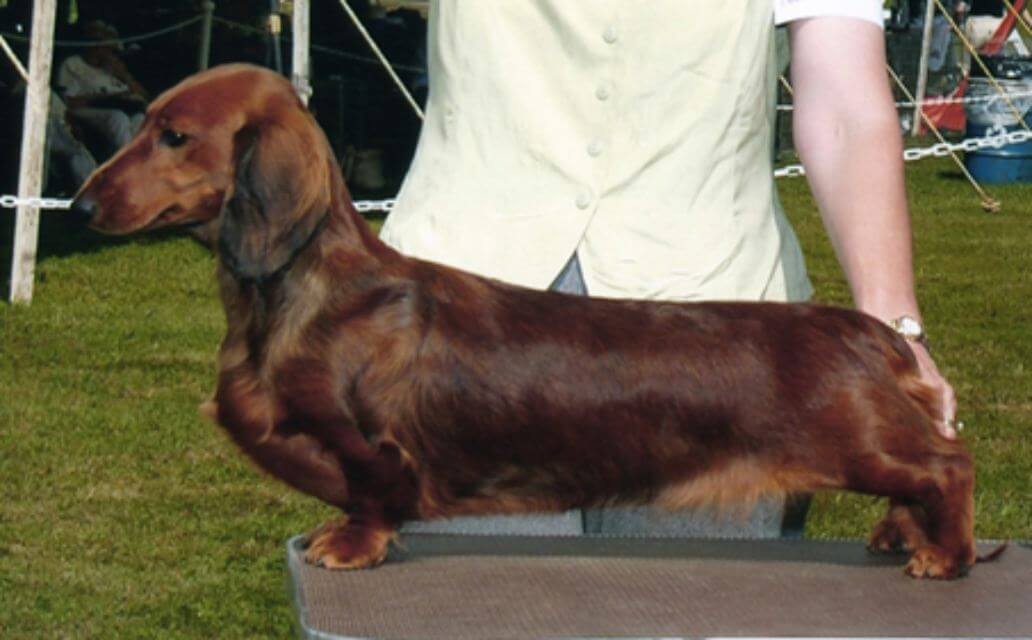
Dachshunds come in two sizes: Standard and Miniature. The Miniature is 11 pounds or under at 12 months of age or older. The only class where Miniatures do not compete with Standards is in the Open Miniature Class, in which they may be weighed.
The Miniature Dachshund is very much a Dachshund and should conform to the Standard. It is not to be considered as less than or different from the Standard Dachshund. Remember, they are bold hunters of rabbit and badger. “Cute” is not in the Standard.
As a hunter, running gear is very important and dogs with weak pasterns should not be rewarded.
The Dachshund’s temperament is described as “clever, lively and courageous to the point of rashness.” The Standard describes shyness as a serious fault. Please give consideration to puppies or dogs that are spooked by a loud noise while on the table. I will often have them do a down and back to settle them and then put them back on the table. Sometimes, I will tell the handler to hold the dog and I will go to the handler’s side of the table to do the examination. I give the exhibits every opportunity to perform. However, shyness is a serious fault.
Proper movement is flowing and smooth, with no extraneous lift in front; rear drive shows full extension of the rear legs. The topline should be held level on the move. We refer to dogs that have little rear extension as “tummy tappers,” as the rear legs reach forward and upward but do not extend back. This is due in large part to steep croups, or long hocks and short second thighs. Lift in front, rather than proper forward extension, is often caused by steep fronts or short upper arms, a fault seen all too frequently in the breed. Dachshunds should cover ground with efficient, smooth movement. Fast movement of front and back that does not cover ground is faulty. Bouncing, lift in front, eggbeater rears, or sidewinding are all symptoms of a lack of balance between front and rear angulation and are not acceptable movement.
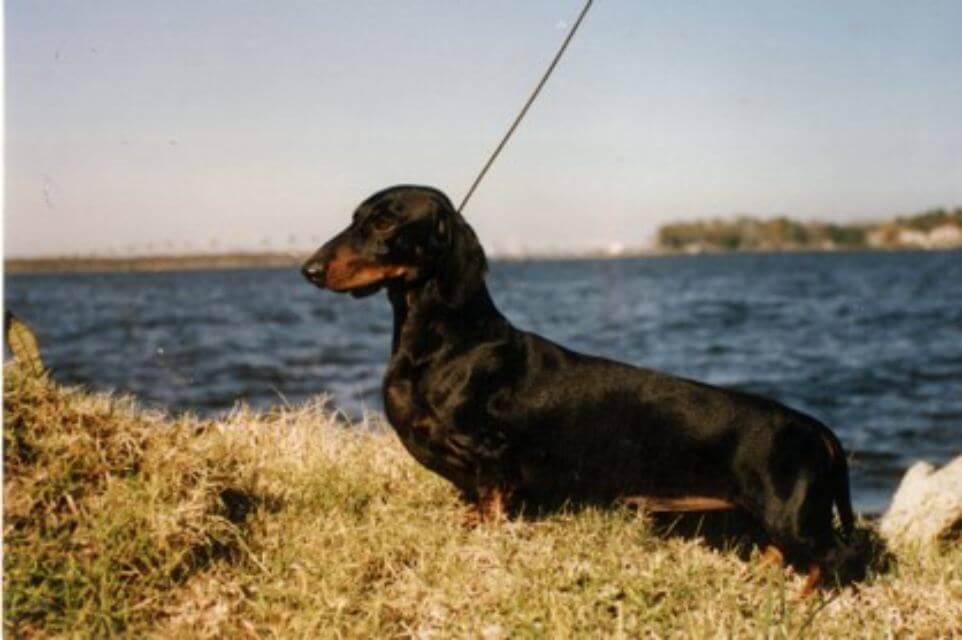
The Dachshund is a great companion, a fierce competitor in Obedience and Agility, and an avid hunter that excels in the field and in Tracking and Earth Dog trials. I hope that this has helped you to appreciate this wonderful, versatile breed and will serve as an aid to judges in their approach to assessing the Dachshund.
